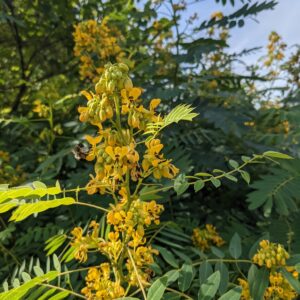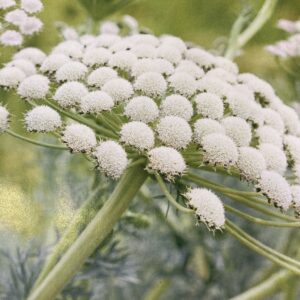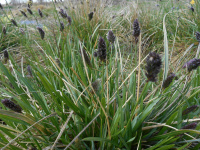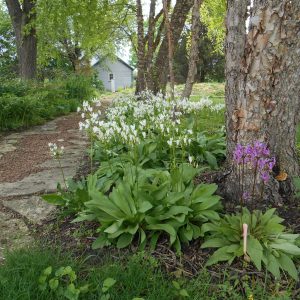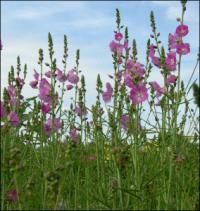Shop
Showing 673–680 of 788 results
-
Senna hebecarpa syn. Cassia hebecarpa Wild senna Z 3-8
Six inch long taxicab yellow flower clusters along the stem in July – August
Six inch long taxicab yellow flower clusters along the stem in July – August
Size: 4’ x 2-6’
Care: full sun in moist well-drained soil
Native: all North America east of Mississippi River from Hudson Bay south to Georgia and Tennessee, Wisconsin native
Wildlife Value: attracts bumble bees and wasps. A legume – it adds nitrogen to the soilCollected by 1753.
-
Seseli gummiferum Moon carrot Z 5-9 self-seeding biennial or short-lived perennial.
Five-inch diameter mound of many circles of pale pink to white flowers atop silvery, frilly, fern-like foliage flowering in mid-summer into early fall.
Five inch diameter mound of many circles of pale pink to white flowers atop silvery, frilly, fern-like foliage flowering in mid-summer into early fall.
Size: 2-3’ x 12-18”
Care: Sun to part-shade in well-drained to moist well-drained soil
Native: Crimea, Turkey and South Aegean
Wildlife Value: Deer resistant. Butterfly magnet; host for caterpillar of Eastern swallowtail butterfly.Seseli is an ancient Greek name of an umbelliferous plant. This species first described by Linnaeus in 1735. Re classified and renamed in 1830 in Prodromus systematis naturalis regni vegetabilis, sive, Enumeratio contracta ordinum generum specierumque plantarum huc usque cognitarium, juxta methodi naturalis, normas digesta.
-
Sesleria autumnalis Autumn Moor Grass Z 5-9
Fresh-green spring narrow blades of grass in summer add airy purplish flower spikes with silver-white stamens on this low mounding, arching grass. Blades have a striking yellow-green color that sometimes develops a soothing golden autumn tint. Spike-like silvery flowers rise above the leaves and mature into soft tan seed heads by autumn.
Fresh-green spring narrow blades of grass in summer add airy purplish flower spikes with silver-white stamens on this low mounding, arching grass. Blades have a striking yellow-green color that sometimes develops a soothing golden autumn tint. Spike-like silvery flowers rise above the leaves and mature into soft tan seed heads by autumn.
Size: 16-18” x 12-18”
Care: sun to part shade in moist well-drained to well-drained soil, drought tolerant
Native: SE Europe east to Caucusus
Wildlife Value: walnut, salt and deer tolerant
Awards: Royal Horticultural Society Award of Garden Merit. Gardens Illustrated “100 Must-Have Garden Plants,” 2013.Collected in Slovenian mountains near Idria, c. 1760 by and 1st described in Flora Carniolica by Giovanni Antonio Scopoli (1723-1788) physician, naturalist and author. Sesleria is named to honor Leonardo Selser, 18th century Italian botanist and physician, contemporary and likely friend of Scopoli
-
Sesleria heufleriana Balkan Moor grass Z 4-9
Spike-like panicles of white in very early spring turning purple atop clumps of gray-blue blades.
OUT OF STOCK
Spike-like panicles of white in very early spring turning purple atop clumps of gray-blue blades.
Size: 24” x 16”
Care: sun to part shade in well-drained soil
Native: open woodlands of EuropeSesleria named for Leonardo Selser, 18th century Italian naturalist and physician, Collected before 1878.
-
Sesleria nitida Nest Moor grass Z 5-8
Spike-like panicles of white turn purple atop mounds of gray-blue blades
ARCHIVED
Note: This is a plant not currently for sale. This is an archive page preserved for informational use.
In early spring, about the time Robins appear, spike-like panicles of white turn purple atop mounds of gray-blue blades
Size: 24”x16”
Care: sun to part shade in most any soil
Native: central and southern ItalyCollected before 1861.
-
Shade Garden
Shade Garden.
ARCHIVED
Note: This collection is not currently for sale. This is an archive page preserved for informational use.
Shade Garden Size : Height x width* Bloom color
3 Asarum canadense – Wild ginger 6” x 6” spreading brown
3 Astilbe chinensis 24” x 24” pink
1 Brunnera macrophyllum – Siberian bugloss 18″ x 24″ blue
1 Chelone glabra – Turtlehead 2-4’ x 12” white
1 Disporum flavens – Fairy bells 25-30” x 16-20” yellow
3 Dodecatheon meadia – Shooting star 12-24” x 6-12” white
1 Hosta ‘Blue Cadet’ 35-40” x 36” lavender
1 Primula veris – Cowslip 8”x 8” yellow
3 Stylophorum diphyllum – Celantine poppy 12-18” x 12” yellow
1 Tricyrtis hirta – Toadlily 2-3’ x 2’ white & purpleAll plants are perennials.
If planted together in one garden these make a 30 square foot garden. **Most of these plants get wider over time by spreading roots or by self-seeding . -
Sidalcea malvaeflora Checker bloom Z 5-9
Bright pink mallow type blooms looking like a miniature hollyhock.
Bright pink mallow type blooms looking like miniature hollyhock.
Size: 2-3' x 10"
Care: sun to part shade in well-drained soil
Native: western No. America
Wildlife Value: Attracts large white skipper butterflies.Sidalcea is the conjunction of sida and alcea. Collected by Mexican botanist José Moziño around 1790 while on the Expedición Real de Botánica, probably in today’s Southern California.
-
Silene alpestris Alpine catchfly Z. 5-8
It flowers in May (through August) the flowers being of a polished whiteness
ARCHIVED
Note: This is a plant not currently for sale. This is an archive page preserved for informational use.
“It flowers in May (through August) the flowers being of a polished whiteness, with the petals notched, and abundantly produced over the shining green masses of leaves.” Robinson 1903
Size: 4-6” x 8-12"
Care: full sun in well-drained soil
Native: European AlpsCollected in Austria by 1773

